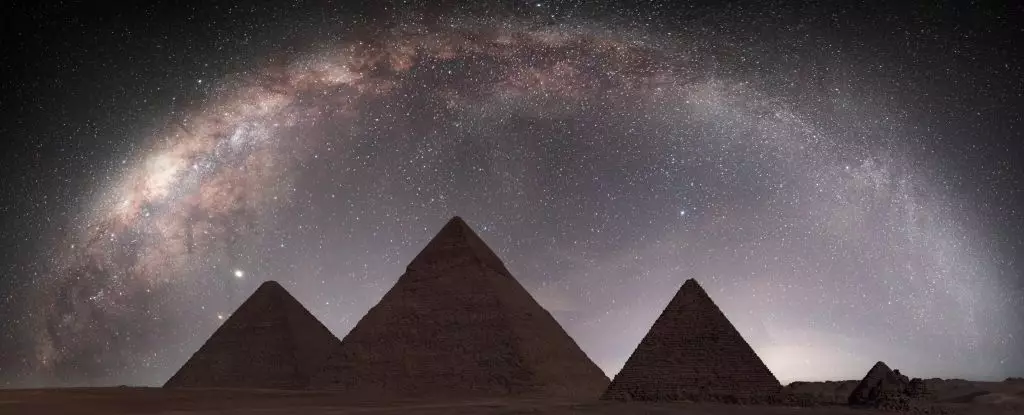The Milky Way captivates countless observers, its luminous stream twinkling against the backdrop of darkness. Yet, this celestial phenomenon may have been an integral part of ancient Egyptian art long before modern astronomers began deciphering its mysteries. Recent investigations led by astrophysicist Or Graur from the University of Portsmouth reveal that artistic representations of Nut, the goddess of the sky, could embody stylized interpretations of the Milky Way itself. This concept not only affirms the synergy between art and astronomy but also invites a profound reevaluation of how ancient civilizations perceived cosmic realities.
Graur’s examination of these ancient artworks—particularly elaborate coffins dating back as far as 4,600 years—provides a unique perspective on Nut’s iconography and its relation to the galactic plane. The vivid imagery depicting Nut, often rendered as a nude woman adorned with stars and cosmic symbols, invites a deeper inquiry into whether these depictions could represent more than mere mythology. The meticulous nature of these artistic details paints a tantalizing picture; the streaks of stars alongside dark, sinuous lines are akin to how we currently visualize the Milky Way, suggesting that the ancients may indeed have known more about the universe than previously thought.
Art as a Cosmic Map
One particular coffin belonging to a woman named Nesitaudjatakhet, an acolyte devoted to Mut and Amun-Re during the 21st Dynasty, serves as a significant artifact in Graur’s analysis. The painted representation of Nut on her coffin reveals a long, undulating line—a feature that resonates closely with the pattern of the Milky Way, which is defined by its bright band of stars interspersed with darker regions of cosmic dust. Graur’s hypothesis posits that this curve may specifically illustrate the Great Rift, the notable dark band within our galaxy. In a compelling juxtaposition, he aligns this ancient portrayal with contemporary photographs of the Milky Way, bridging the gap between past and present.
Notably, Graur acknowledges that while this remarkable feature appears in Nesitaudjatakhet’s coffin, it is an anomaly among Nut’s representations. The rarity of such a depiction raises essential questions: What does it signify about the relationship between Nut and the Milky Way? Are we seeing a singular artistic interpretation or a broader cultural acknowledgment of celestial phenomena? The scarcity of representations featuring the undulating line suggests that while Nut may be linked to the cosmos, she transcends a mere representation of the Milky Way itself.
Nuanced Interpretations of Deity and Cosmos
The interplay between Nut and the Milky Way sheds light on the complexities of ancient Egyptian spirituality. Graur insists that while there is a connection between the goddess and the galactic plane, they are not equivalent. Rather, he posits that the Milky Way, along with the sun and stars, adorns Nut’s celestial form as individual phenomena that collectively illustrate the grandeur of the sky she represents. This distinction is critical; it suggests an intricate framework in which the Egyptians perceived their world, where celestial bodies and deities coalesce, rather than exist in isolation.
Furthermore, Graur’s findings underscore a fundamental aspect of interdisciplinary research—the merging of the arts and sciences. This synthesis ignites fresh perspectives and challenges longstanding assumptions about how ancient cultures understood their environment. By cross-examining ancient texts with artistic depictions, researchers can embark on a journey to unveil the layers of meaning imbued within these masterpieces, reflecting not only astronomical knowledge but also theological beliefs.
The Call for Digitization and Accessibility
Graur’s research emphasizes an often-overlooked issue within academia: access to resources. He advocates for the digitization of museum catalogs and public accessibility to these treasures, which would enable scholars and enthusiasts alike to explore ancient art and its myriad interpretations. The breadth of knowledge hidden in these catalogs has the potential to illuminate not only the relationship between deities like Nut and celestial phenomena but also broader themes of human curiosity and enlightenment throughout history.
In a world where information is increasingly digitized and shared, fostering an environment where ancient artifacts can be analyzed and appreciated should be a priority. The ancient Egyptians’ insightful interpretations of the cosmos remind us of our enduring quest for understanding amidst the vastness of our universe. As we continue to unearth connections between art, spirituality, and science, we’re invited to inspire future generations to look skyward and ponder their place within the celestial tapestry.

